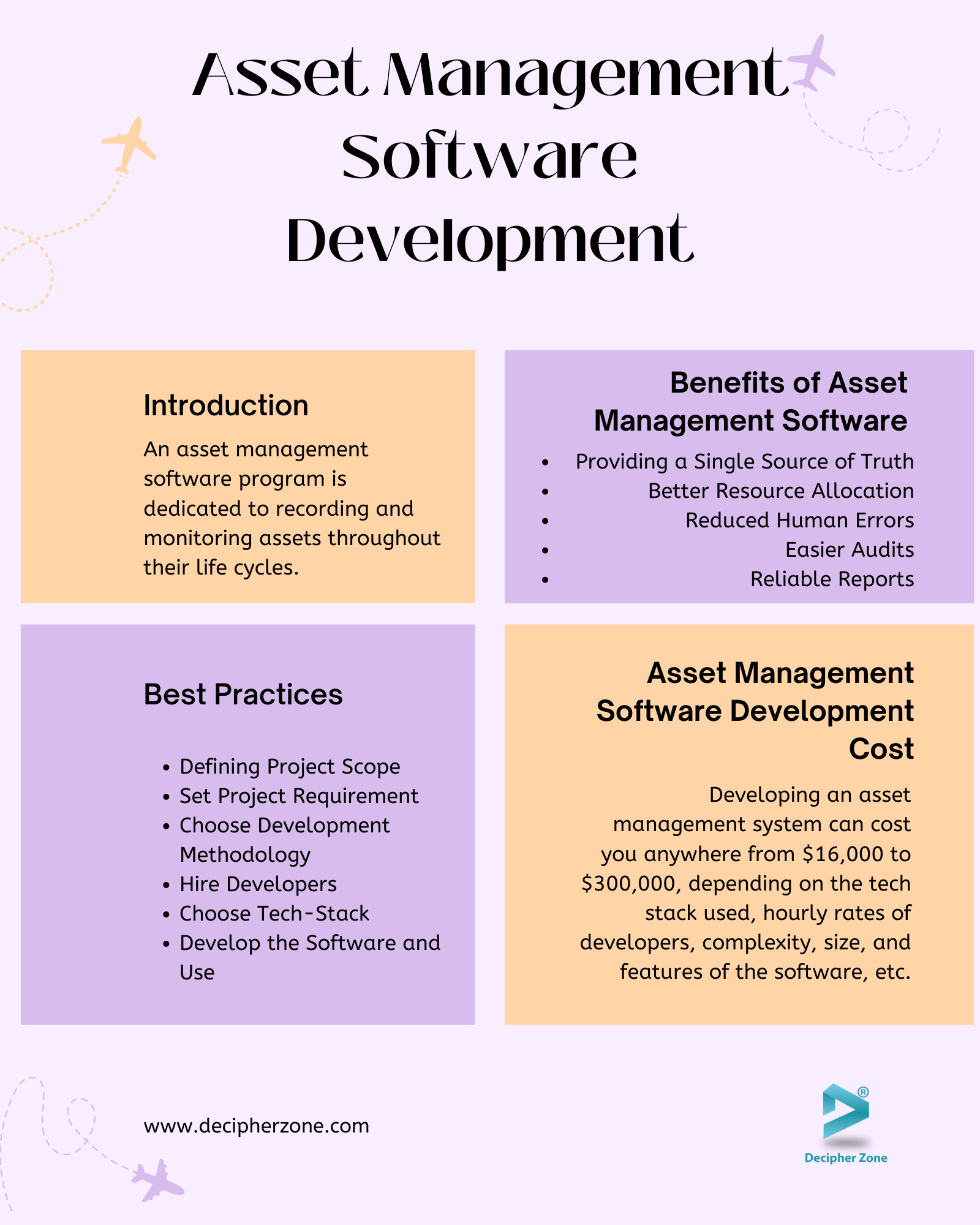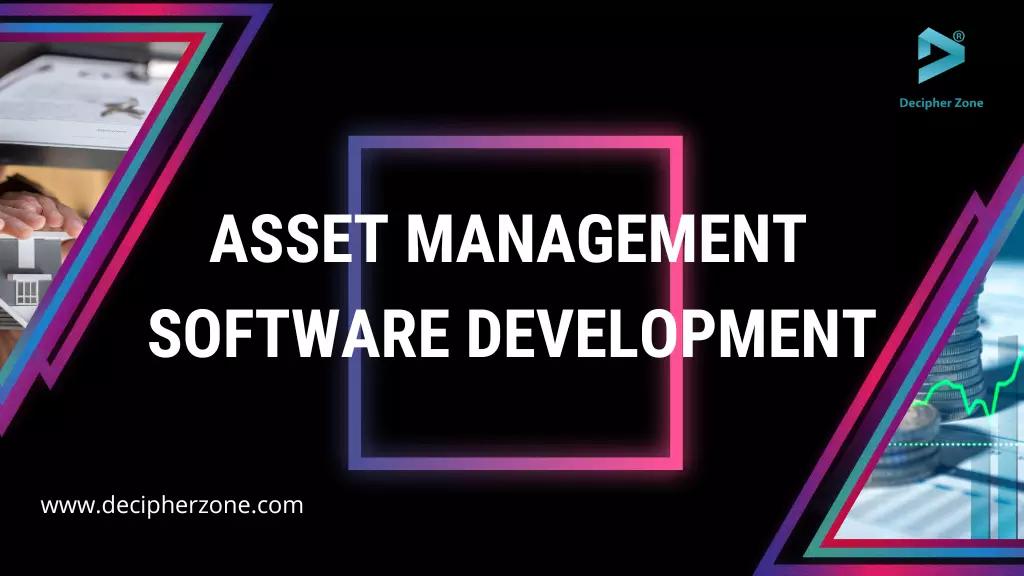Asset Management Software Development Cost, Features and Benefiits. In today’s fast-paced world, keeping track of both physical and digital assets and managing them is crucial. Traditionally, to manage assets you needed to create numerous spreadsheets, but entering all the details manually when you own multiple assets can be tedious and prone to errors.
To overcome the issue of traditional asset management, businesses are now turning to asset management software solutions that not only reduce human errors but also improve scalability, efficiency, and reliability while accessing asset data across organizations.
But what exactly is asset management software? To help you understand, we will walk you through everything you must know about asset management software solutions. So, let’s start right away.
Asset Management Software Development
An asset management software program is dedicated to recording and monitoring assets throughout their life cycles. It tracks every aspect of an asset from procurement to disposal and records information such as its location, usage, and other minor details.
Read: Fleet Management Software Development
Not only that but asset management software solutions also help businesses in maximizing asset utilization, tracking vendors, maintaining license compliance, optimizing asset allocation, and making informed decisions through cost transparency.
Read: Field Service Management Software Development
Also, according to Grand View Research, the market size of asset management software globally which was valued at $373.69 billion in 2022, is expected to grow at a CAGR of 34.7%.
Read: HR Software Solutions Development
Some of the major features that you should consider implementing in the asset management software are automated maintenance scheduling, location tracking, mobile access, real-time reporting, customizable workflow, audit trails, and third-party API integrations
Benefits of Implementing Asset Management Software
With a basic understanding of what asset management software is all about, let’s dive into its benefits. A few of them are:
Providing a Single Source of Truth
In the traditional way of asset management, it was common for assets to get tracked at multiple locations by different people, leading to chaos and inaccuracies.
However, as the asset management software records, tracks, and stores details of every asset at one centralized location, it offers a single source of truth for the entire organization. This allows employees to focus on other crucial tasks rather than relegating time and brain to monitoring the company’s assets.
Better Resource Allocation
With the centralization brought by asset management software, it becomes easier to find and reallocate assets in the workflow, reducing workstream replication as well as production costs.
Reduced Human Errors
Among different problems that used to come with manually maintaining assets, human errors have the most significant impact on management. Undoubtedly, the process of inputting details of numerous assets in the spreadsheet can be tremendously tiring, leading to an increase in errors and mistakes.
On the other hand, using asset management solutions helps in automating the task of tracking these assets which leads to minimal human errors.
Easier Audits
Auditing assets is one of the most crucial tasks for efficiently managing organizational assets. But doing so manually will result in different problems, especially record mismatches. Using asset management software makes it easier and more reliable to audit assets in record time, eliminating any problem that might come with traditional asset management.
Reliable Reports
Reporting is something that helps in understanding the growth of the company, and the asset management software assists you with just that. It allows you to easily find out whether there's a loss or profit in your organization depending on the number of assets recorded in the balance sheet.
Read: Software Solutions for Manufacturing Industry

Best Practices for Successful Asset Management Software Development
While developing any software including but not limited to asset management software, some of the best practices that you should consider are as follows:
-
Project scope is the first thing you need to set before planning a development plan. Creating an adjustable plan that can be modified later on is a plus point as it helps in starting the software development with a clear vision and avoiding any sort of difficulties.
-
Once you have a clearer idea of what you want to achieve, it is essential to list out all the requirements by creating a software requirements specification document based.
-
Next, you need to choose software development methodologies among Agile, Scrum, Kanban, Waterfall, etc. depending on the requirements, specifications, and time frames.
-
Once you have decided on the basic necessities of software development, you need to search for a custom software development company like Decipher Zone Technologies to build one for your business, contact them, interview developers, get a quote, and hire them.
-
Share software requirements, communicate to choose the right tech stack, take meetings for progress updates, verify software quality, get your product developed and launched in the market, and work on any feedback you receive to improve the software performance for users.
Read: Software Solutions for Oil and Gas Industry
Conclusion
So that was all about asset management software development. We hope that this blog has helped you understand what asset management software solutions are, why you need them, and their benefits in a business.
Needless to say, this software is here to stay for the long term and helps organizations monitor and manage their assets more effectively. And if you too are planning to build an asset management software for your business, then contact our team of experts, share your requirements, hire experienced developers post-interview, and get your software developed within your budget.
FAQs: Asset Management Software Development
What is asset management system software?
An asset management software program is dedicated to recording and monitoring assets throughout their life cycles. It tracks every aspect of an asset from procurement to disposal and records information such as its location, usage, and other minor details.
What are the benefits of asset management software?
Better resource allocation, minimized human errors, easier audits, reliable reports, and being a single source of truth are some of the major benefits that you will witness when investing in asset management software.
How much does it cost to develop asset management software?
Developing an asset management system can cost you anywhere from $16,000 to $300,000, depending on the tech stack used, hourly rates of developers, complexity, size, and features of the software, etc.

